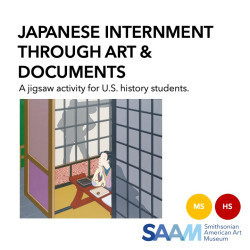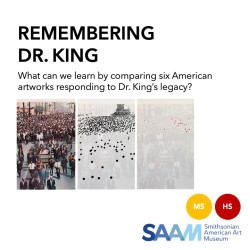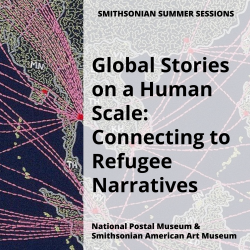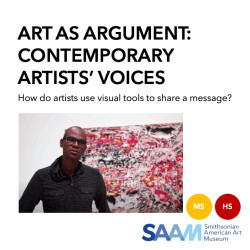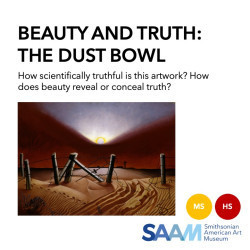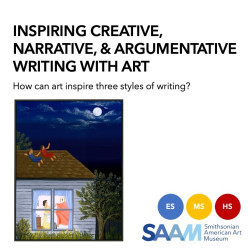Phoebe Hillemann
Teacher Institutes Educator
Smithsonian American Art Museum
As the Teacher Institutes Educator at the Smithsonian American Art Museum, I organize our week-long summer institutes for middle and high school English and social studies teachers: http://americanart.si.edu/institutes. I'm interested in interdisciplinary thinking, arts integration, and the power of dialogue in learning spaces.
Phoebe Hillemann's collections
Japanese American Incarceration through Art and Documents
<p>These resources can be used in an activity that introduces a lesson on Japanese American Incarceration during World War II. </p>
<p>1. To begin, show students Roger Shimomura's painting entitled Diary: December 12, 1941. Without providing any background information, use the "Claim, Support, Question" routine to have students make claims about what they think is going on in the artwork, identify visual support for their claims, and share the questions they have about the painting. Document responses in three columns on large chart paper or a whiteboard.</p>
<p>2. Following this initial conversation, share the title, artist's name, and date of the painting. Ask students to consider the date in the title, and discuss what significance this date might have. If they don't figure out that this date was five days after the Japanese bombing of Pearl Harbor, share that information. Share with students that this painting is part of a series Roger Shimomura created based on the wartime diary entries of his grandmother, Toku, who was born in Japan and immigrated to Seattle, Washington in 1912. Along with thousands of other people of Japanese ancestry living on the West Coast during World War II , Toku and her family were forcibly relocated to an incarceration camp after the attack on Pearl Harbor. Roger was a young boy during World War II, and remembers spending his third birthday in the Puyallup Assembly Center on the Washington state fairgrounds, where his family was sent before being transferred to Minidoka Reservation in Idaho for the duration of the war.</p>
<p>3. Jigsaw Activity, Pt. 1. After sharing this context, tell students they will each be receiving a primary source document that relates to the painting in some way. Distribute copies of "Woman at Writing Table," the Superman comic, the Instructions to All Persons of Japanese Ancestry, and Toku Shimomura's diary entries. Divide students into four groups, one per document. Give students time to analyze their document as a group and discuss how it affects their interpretation of the painting.</p>
<p>4. Jigsaw Activity, Pt. 2. Next, create new groups so that each group includes students who received each of the four sources. Ask students to briefly report on their document and what their original group discussed as its possible meaning and relation to Roger Shimomura's painting.</p>
<p>5. Return to the painting as a large group, and discuss how the primary source documents have influenced students' reading of the artwork. </p>
<p>6. Optional additional resource: If time allows, have students watch excerpts from Roger Shimomura's artist talk at the Smithsonian American Art Museum.</p>
<p>#APA2018</p>
<p><em>#visiblethinking</em><br></p>
 Phoebe Hillemann
Phoebe Hillemann
9
Remembering Dr. King: Six American Artists Respond
<p>April 4, 2018 marks the 50th anniversary of the assassination of Martin Luther King, Jr. These six artworks from the Smithsonian American Art Museum's collection were created between 1968 and 1996, and respond to Dr. King's legacy in different ways. What does the date of each artwork tell us about the context during which it was made? What can we learn from looking at them as a collection?</p>
<p>Created for a March 1, 2018 webinar for alumni of SAAM's Summer Institutes: Teaching the Humanities through Art. </p>
<p><a href="https://americanart.si.edu/education/k-12/professional-development/summer-institutes" style="background-color:rgb(63,63,63);">https://americanart.si.edu/edu...</a> </p>
<p>#saamteach #martinlutherkingjr #mlk</p>
 Phoebe Hillemann
Phoebe Hillemann
8
Global Stories on a Human Scale: Connecting to Refugee Narratives
<p>How do we connect students with global issues, such as refugee crises? How do we move from listening and learning to taking action?<br></p>
<p>The resources in this collection were created for a collaborative session organized by the National Postal Museum & Smithsonian American Art Museum during the 2021 Smithsonian Summer Sessions for Teachers: Interrogating the Stories We Tell. </p>
<p>#SummerSessions</p>
 Phoebe Hillemann
Phoebe Hillemann
14
Inspiring Creative, Narrative, & Argumentative Writing with Art
<p>Explore different styles of writing in response to American art! This digital collection suggests artworks from the Smithsonian American Art Museum to use to inspire creative, narrative, and argumentative writing, along with suggested thinking routines and writing prompts. The categories are fluid -- many artworks can be used successfully for more than one type of writing!<br></p>
 Phoebe Hillemann
Phoebe Hillemann
37

